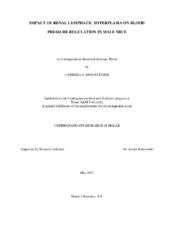| dc.description.abstract | Chronic high blood pressure, or hypertension, is identified as a risk factor for heart disease, stroke, and chronic kidney disease. The primary cause of most hypertension is increased peripheral vascular resistance that is controlled, in large part, by the kidney’s water handling. In the kidney, specific immune cell subsets and overall renal inflammation have both been identified as drivers of hypertension in preclinical models. Lymphatic vessels serve as a route of both fluid and immune cell clearance and their expansion, lymphangiogenesis, is necessary for the resolution of tissue inflammation. We hypothesized that by increasing renal lymphangiogenesis, renal inflammation would be reduced and blood pressure would be normalized during salt-sensitive hypertension. To investigate the role of renal immune cell trafficking in instances of blood pressure challenge, we employed a murine model of inducible renal lymphatic expansion. Mice expressing a lymphatic growth factor, vascular endothelial growth factor (VEGF)-D, under the control of a TRE-promoter were crossed with mice expressing a Kidney Specific Protein-regulated transactivator (rtTA). Upon administration of doxycycline, the rtTA-dox complex binds to the TRE promoter region, causing transcription of VEGF-D only in renal tubular epithelial cells. The resultant kidney-specific VEGF-D overexpression caused expansion of the existing renal lymphatic network in addition to generating de novo lymphangiogenesis in the cortex of “Kid-VD” mice. We then utilized the Kid-VD mouse model during an established rodent hypertension regimen of nitric oxide inhibition and high salt diet loading to identify the impact – through weekly blood pressure measures - and mechanism – by cellular, protein, and RNA analysis – of expanded renal lymphatics on blood pressure regulation. Lymphatic circulation may thus provide a new target for the treatment of chronic hypertension and its associated co-morbidities. | en |


